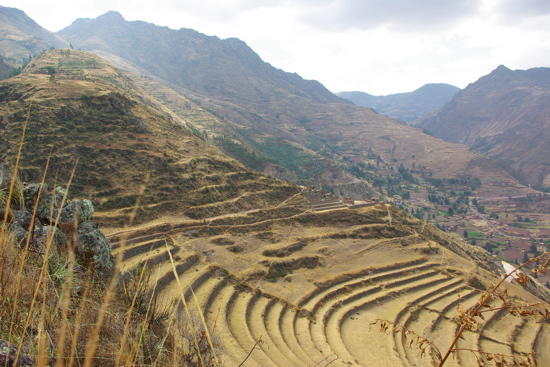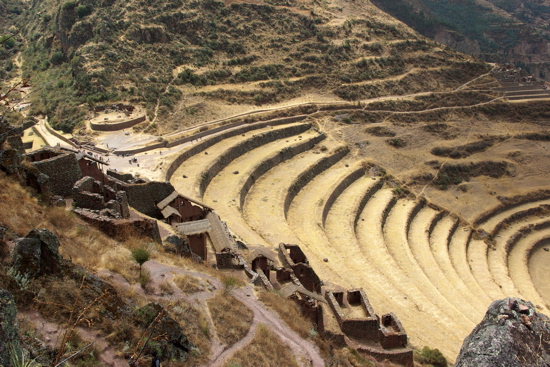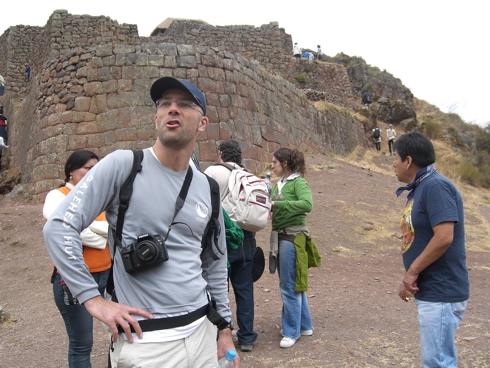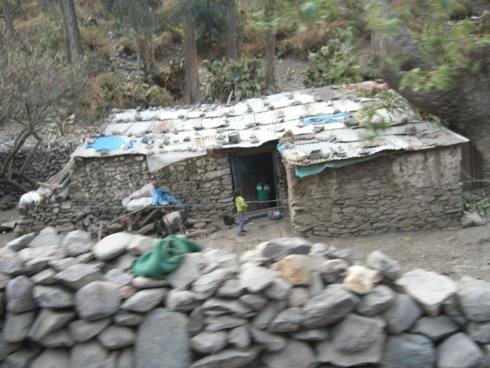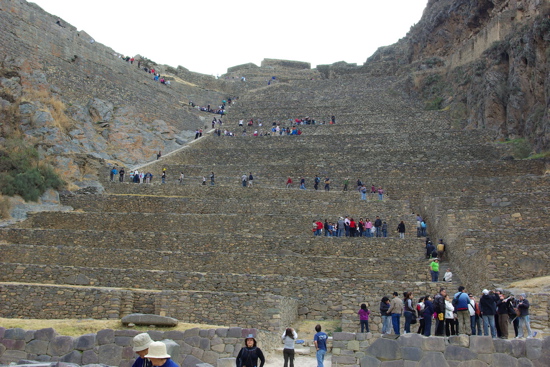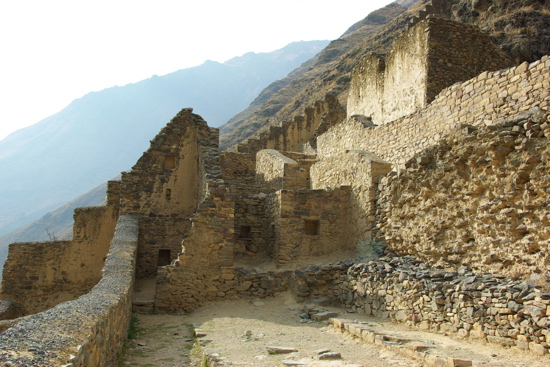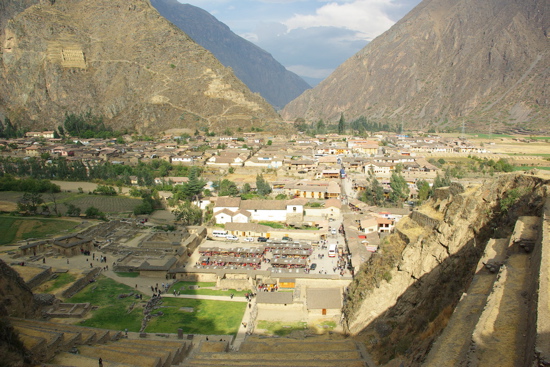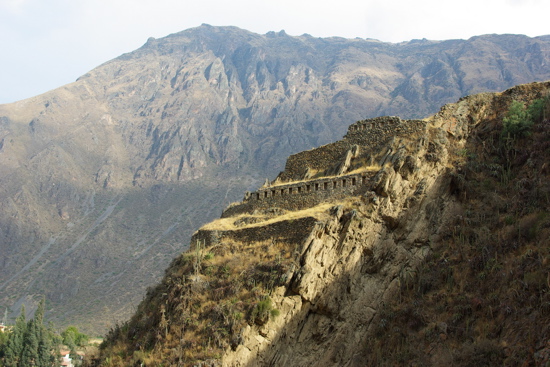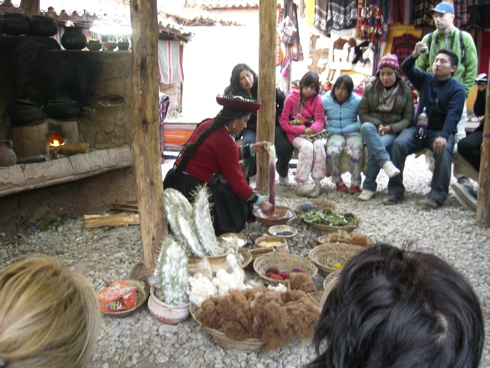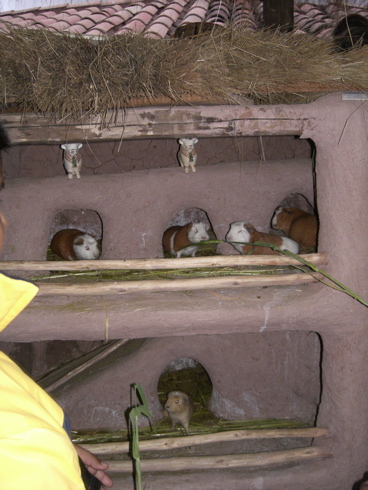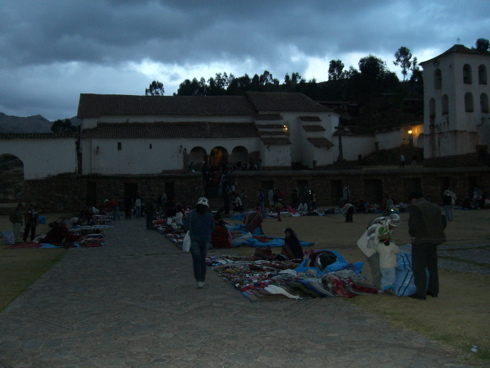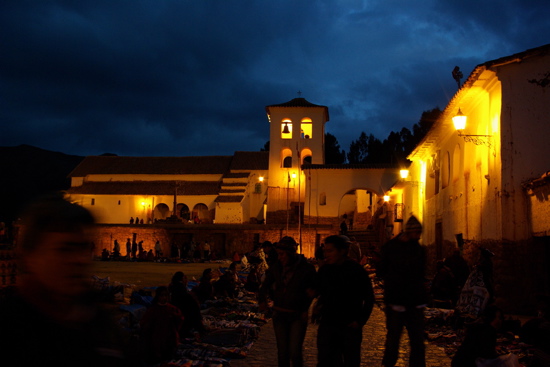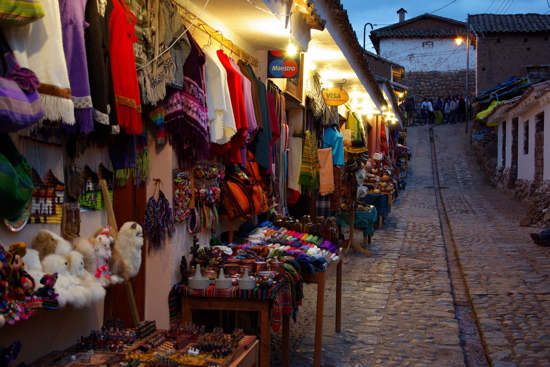Our last day in Cusco, we took a day trip to the Sacred Valley, an area that boasts several major Inca sites and other various touristy areas. Perhaps ill-advisedly, on Friday we stopped in a tourist-baiting storefront near the Plaza de Armas and arranged the tour with a petite Peruvian woman who spoke good English. We paid 110 soles (about $40) for both of our bus tickets and lunches (this did not include the entrance fee for the three sites, which was another 140 soles — surprisingly pricey). The petite Peruvian advised us to come back Sunday morning at 8am in order to board the bus.
We arrived back at the storefront at Sunday morning at 8am only to find it closed. The petite Peruvian finally appeared at 8:15am and rushed us four blocks away to a city square flanked by various tour buses. “Wait here,” she ordered, and disappeared for 20 minutes. When she reappeared, she gestured frantically to a bus, which we boarded, and that was the last we saw of her. Another woman came by to take our names and hotel. The bus slowly filled up, and then a man ordered all of the Spanish speakers to get up and move to another bus, while roughly a half-dozen Anglophones were put on our bus. Finally, around 9am, the bus began to move.
But the bus was only half-full. We arrived at a hostel in a sketchier part of town and picked up an extended family of Peruvian Americans (the older generation was native Peruvian, but they all lived in New York and the four ‘tweenaged kids spoke no Spanish). The family filled out the seats around us. We idled for a bit as we waited for the bachelor Uncle Estaban to emerge from the hostel. Apparently, he was taking a shower. The bus returned to the square, where we picked up more people until the bus was full. By then, it was 9:30am, we had been on the bus for an hour, and we hadn’t gone anywhere.
Finally, finally the tour guide picked up the microphone and the bus left Cusco. We drove for about 45 minutes on winding mountain roads until we pulled over at a pseudo rest stop that consisted of two unflushable toilets and a large amount of souvenirs — not anything different than the touristy crap in Cusco, but the Peruvians Americans immediately began buying everything in sight: gloves, scarves, bags, carved frogs, and bird whistles. They boarded the bus, fully loaded with new toys to occupy their attention as the guide droned on about history and archaeology and stuff.
By the time we arrived at the Pisac Inca Ruins, I was dying to get off the bus. We bought our ticket and began hiking with the group up to the ruins. It wasn’t a very steep hike, yet most of the Peruvians-Americans began huffing and puffing. Honestly, it looked like many of them haven’t engaged in an activity more strenuous than opening a can of SpaghettiOs in many, many years. One Ecuadorian woman in her 60s strode past the 12-year old Peruvian-American boy named Eddie, a sonorous, rotund lad whose mother and grandmother fussed over him constantly (when they themselves weren’t breathing heavily from the effort of hauling their distended bodies up a few steps). At first I found amusement in their agony, but very soon it made me sad. This is what America does to people. It turns them into slothful lardasses.
Anyway: Pisaq. What a view.
The huge complex of ruins sat atop a great valley; across the rift, we could clearly see hundreds of catacombs. Unfortunately, we didn’t have time to fully tour the ruins, which contained numerous temples, citadels, and other important structures.
After a brief explanation from our guide, we hurried back to the bus.
On the way back to the bus, there were women selling souvenirs and also ears of corn. Most of us managed to resist buying an ear of corn, because lunch was less than 45 minutes away. But not Uncle Estaban, who boarded the bus 5 minutes late holding two ears of boiled corn. Meanwhile, his young niece was vomiting into a bag as her father held her hair back. They were sitting right in front of us, and the tour guide whisked them off the bus so she could be administered oxygen for altitude sickness. They came back 15 minutes later. Her extended family munched on corn as she continued to vomit into a bag.
We drove on. I looked out the window, a little stunned by the poverty I saw: Houses without windows, children without shoes. Living in America, it’s too easy to forget how the other half lives.
We stopped for a buffet lunch in Urumba. It wasn’t half-bad, but it wasn’t half-good, either. Then, we continued onto Ollantaytambo, where another Incan site awaited.
Lots of steps on this one! Most of the Peruvian-Americans stayed at the bottom, having been recently reminded of their dismal physical limitations. Young Eddie persevered onward.
Too soon we were ushered back onto the bus to continue onto our final stop, Chinchero, which has no Inca ruins but a thriving market with high-quality crafts. When we arrived at Chinchero, we were given a demonstration of how they make those beautiful textiles that are available for purchase.
I was distracted by the community of guinea pigs located near the fire. Poor little delicious guinea pigs!
Then we were unleashed on the vast Chinchero markets.
We were due back on the bus at 6pm so we could arrive in Cusco at 7pm. The Peruvian-Americans lumbered onto the bus at 6:10pm with copious amounts of purchases. I wanted to leave without them, but once the bus started to move, I stopped caring. Tomorrow was Machu Picchu, and we had to wake up at 4:45am to be ready for the start of our trek. I tried to nap, but just when I started to drift off to sleep, the driver started to blast Hispanophone music, a grating duet of a low-pitched man and high-pitched woman set to upbeat rhythmic Latin music. So I stayed awake and looked out the window. I saw a man being mauled by a pack of stray dogs (a ubiquitous sight in Peru — stray dogs, that is). This witnessing would later be confirmed by a woman on the tour bus who would happen to be on my Inca Track. When we arrived in Cusco, we hurried to our hotel for dinner and our last night in actual beds before the Inca Trail commenced…
